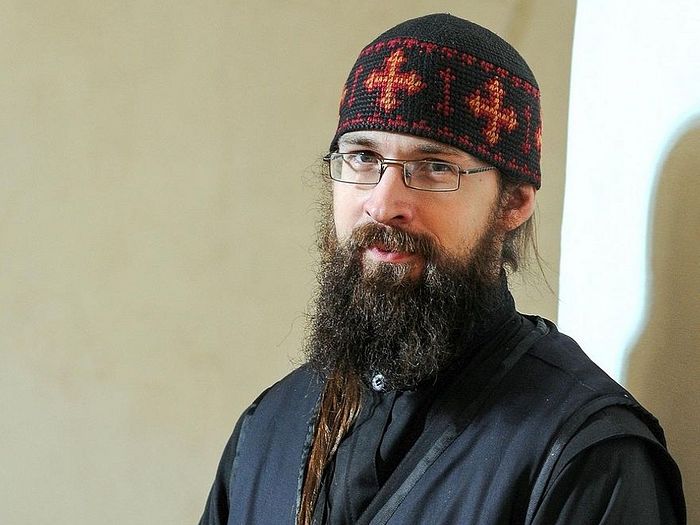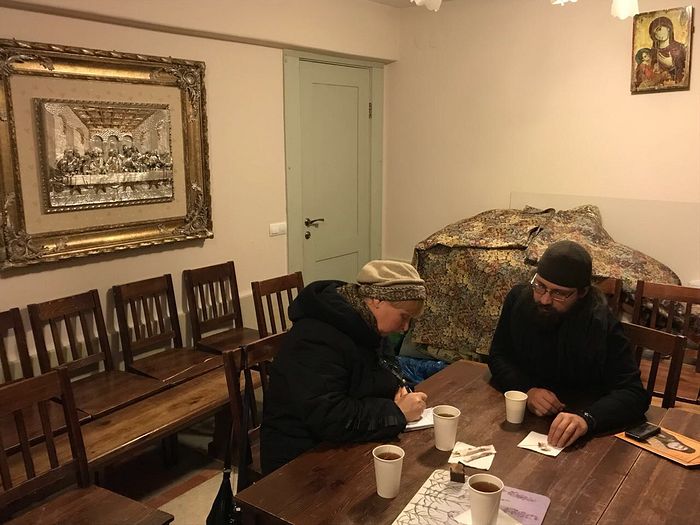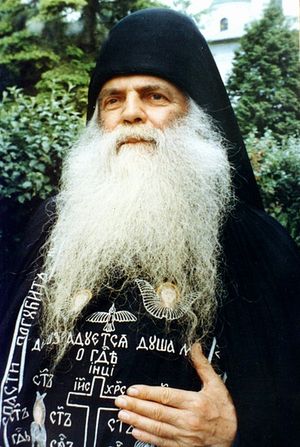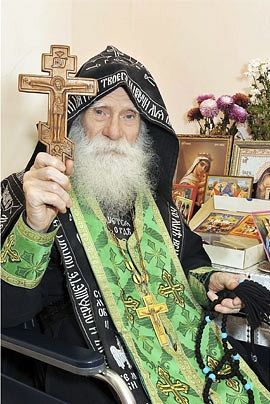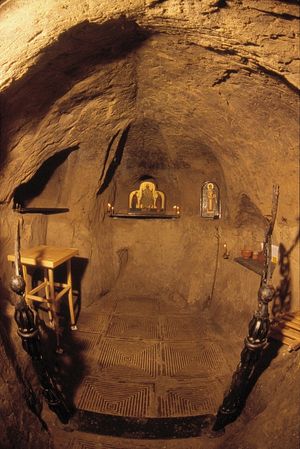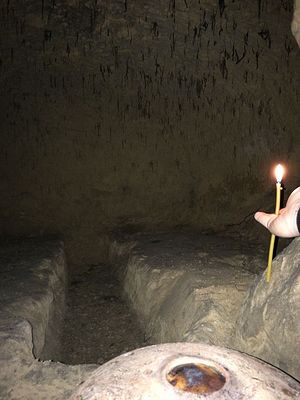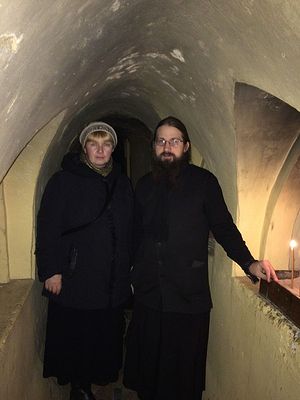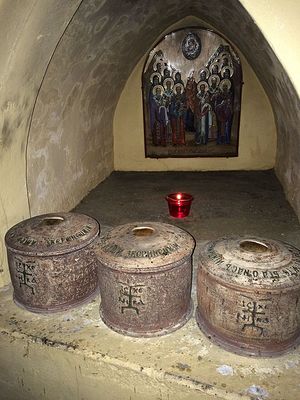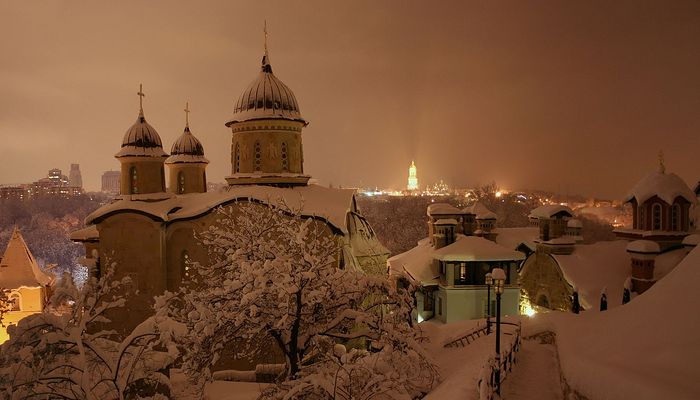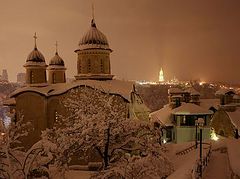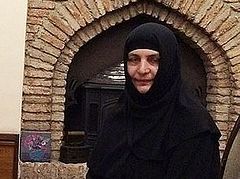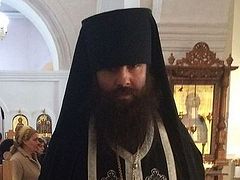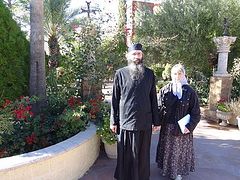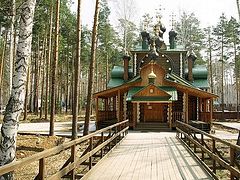The deputy abbot of the Zverinets Monastery of the Holy Archangel Michael in Kiev Archimandrite Leonty (Zolotarev) speaks about the role of Divine Providence in choosing one’s life’s path, and recalls his meetings with grace-filled ascetics and the wonderful miracles of God performed through the intercessions of the venerable fathers of Zverinets Monastery.
—Fr. Leonty, God’s providence is present in everybody’s life. Sometimes providence is hidden, but in some cases it becomes clearly evident in signs, significant events, or the right words heard at the right time. Have you ever personally experienced such signs and the providence of God working in your life? How did you come to believe in God?
—I was born to a believing yet unchurched family. In the early 1990s, many developed a keen interest in faith, so my parents decided to go to church and, of course, they took me with them.
I had already been to church before then. My grandmother lived in Kuban [now chiefly the Krasnodar territory in South Russia] with its numerous Cossack villages. In my early childhood my parents would take me there to stay for a while with grandma. And we would go to church together with her: I remember how she took me to Communion when I was about five. According to my grandmother, I enjoyed going to church, looked at icons closely and behaved well.
I have vivid memories of how I was stunned by the images of Christ, and Apostle Peter sinking in the sea on a fresco. I felt great sympathy for Peter. I still distinctly remember that feeling: Peter won’t drown because the Lord will save him! The Savior helps those drowning in the turbulent waters of the sea of life, relieves their sorrows, comforts the weak.
The story with my baptism is very interesting. I was about one year old, and it happened in a miraculous way. My mother and her friend brought me to church, and the priest asked: “Where is your godfather?” And mother replied: “We don’t have a godfather. There is only a godmother here!”
It was a weekday, 1984, everybody was at work, and the church stood empty. Thus my baptism was nearly postponed to an unknown date.
All of a sudden the door opened and, to the amazement of the priest along with my mother and her friend, a sailor came into the church. Next he approached an icon of St. Nicholas the Wonderworker and lit a candle in front of it. As it turned out, he was on leave, and before his return to the sea decided to pray to St. Nicholas. The priest immediately started persuading that man and in the end he became my godfather. If he hadn’t come to the church at that very moment, my baptism wouldn’t have taken place (priests were obliged to register a man as a godfather for each baptized boy).
My first encounter with a holy elder occurred in my childhood. At that time the revered elder Schema-Archimandrite Theophilus (Rossokha; 1929-1996) lived at the Kitaevo Monastery of the Holy Trinity in Kiev. He served as a monk and pastor for over forty years. Throughout his life the elder zealously performed spiritual labors, prayed fervently and endured numerous sorrows and persecutions.
When I was seven or eight years old, I fell seriously ill and suffered with a fever. Mother took me to the church and led me up to the elder. She pushed me slightly and I found myself in the very midst of a large crowd right in front of the holy man.
Our eyes met, and I saw his face very clearly: a grey beard and a loving look. The elder blessed me and I felt some kind of warmth. And I came back home completely healed.
But, please, don’t get me wrong! I am not calling on anyone to only bring their sick children to church instead of seeing a doctor and to choose sailors they’ve never met before as their godfathers! I am just sharing my personal experience and giving an account of what happened to me in the childhood and which was certainly providential. Each person has his own spiritual experience.
—So you and your parents started attending the church regularly?
—There is a wooden Church in honor of the Hieromartyr Macarius on Tatarka Hill, Kiev, which is over 100 years old. So my family and I began to attend it regularly.
Key, decisive moments of my spiritual life were yet to come. When I was about fourteen my mother and I came up to a priest at the above-mentioned Kitaevo Monastery, wishing to get answers to some important spiritual questions.
I asked, “How do I determine the will of God for my life? How to choose the right path in life?”
And the priest unexpectedly answered this way: “Don’t worry about it! If you want to serve the Lord, then He will set you on the right path and make you a priest!”
Though I remembered that answer and kept it in my heart, I didn’t attach any special importance to it and even didn’t consider studying at a theological seminary as a serious life’s path choice.
— What did you want to be then?
—In my youth I was interested in psychology, philosophy, economics. After school I enrolled in the Department of Sociology and Psychology of Taras Shevchenko National University of Kiev. I wanted to study psychology because I realized that there was something inside human beings—something inner and invisible—and the knowledge of it enabled psychologists to help people and solve their problems. In fact I was thinking of the soul. And, of course, I wanted to understand myself better.
At that time I was not aware that psychology is a science that actually studies the human soul, but that it approaches it as some adjunct to the body, as a projection of certain psychophysiological processes. Thus, for a psychologist the soul is not a self-sufficient component, it is rather (at least to a certain extent) a result of the activity of physical, organic and biochemical processes.
Moreover, psychologists themselves still cannot figure out where biochemical processes end and where a thought, an image begins…
Little by little I began to perceive psychology as an instrument for affecting human behavior—earlier, the humanities were a branch of knowledge where there was no place for God. I graduated from the university, and in my final year I worked at a research firm and was fairly well off.
I gradually became conscious that today psychology is mainly focused on achieving internal stability, harmony, remaining in your “comfort zone”, in isolation from the true needs of your soul—that is, communion with God and the struggle with sins. I am not speaking about Orthodox psychologists—there were no such psychologists then.
When you seek only mental comfort, you pursue temporary things by sacrificing eternal ones. And, once you have achieved this “serenity”, you become like the main character of the following story from the Lives of the Holy Fathers:
“In one monastery there lived a monk who remained absolutely calm on being reproached and even insulted by the brethren. When asked by the elder how he had succeeded in attaining such dispassion, the monk replied: ‘Should I pay attention to the barking of dogs?’”
Therefore, retaining one’s composure is not always good.
—Fr. Leonty, for justice’s sake let me make reference to the work of Orthodox psychologists. True, it should be mentioned that the earliest books and articles on Orthodox psychology appeared only after the year 2000, while Orthodox psychology as a separate branch took shape even later. At the present time there are over 100 active counselling, rehabilitation and crisis centers that provide Orthodox spiritual and psychological help. There are also teaching and learning resources on the subject, and departments of Orthodox psychology have opened at many educational institutions. Yet our talk is on a different theme… How did you end up at the monastery?
—My education allowed me to be both a teacher and a researcher, but I used secular science only as a way to earn income…
In 2006, I started attending talks on spiritual life organized for young people at the Holy Trinity Monastery of St. Jonas. After that course I began to assist in the church. In the same year I went to the “Brothers” Orthodox youth festival, after which I started thinking more seriously about becoming a monk.
However, at the same time I felt that I was not ready to abandon the world as I was too attached to my way of life: I liked communicating with my friends and valued the opportunities to travel to other cities and towns…
Nevertheless, I started making pilgrimage trips: to Diveyevo Convent, to Optina Monastery, and around the “Golden Ring” of Russia.1 By 2008 I firmly decided to take up monasticism, not the least thanks to my meeting with two saintly figures.
These were Schema-Hieromonk Amphilochius (Trubchaninov; 1917-2011), a disciple of the ever-memorable Archimandrite Seraphim (Tyapochkin; 1894-1982), and Schema-Nun Xenia of Gomel (†2010). All who knew Elder Amphilochius recalled his extraordinary patience, sincere love for people and gift of prayer. He was very supportive of my ambition, but adjured me not to hurry. The elder gave me a prayer rule to observe, advised me how to pass from secular life to monastic life, and how to choose the right monastery.
As for Mother Xenia, she was a great woman of prayer who lived in Gomel [in Belarus] permanently but would come to Kiev from time to time. Independently of each other, both of them told me that I would be able to best fulfil my potential in monastic life. They explained to me that in monasticism I would be able to learn to struggle with my own will and serve other people to the fullest by the best qualities of my soul.
The advice of these true ascetics was addressed to me personally; perhaps they would counsel others to choose the path of married life.
— And then you came to the monastery?
— When I came to Fr. Amphilochius and asked his blessing for monastic life for the first time, the elder answered: “You are still not ready for monastic life. Some ‘tails’ should be ‘cut off’.”
The elder was speaking about my ties with the world.
In 2008, Fr. Amphilochius gave me his blessing to look at some monasteries and choose the one that would suit me best. First I went to Optina Monastery. At that time I was afraid of large monasteries and thought that one could lose the sense of belonging to one family in a huge community of monks.
I had lost my passport just before the departure, so I hastened back home to get my passport for travelling abroad and only by a miracle did I manage to catch my train… So I began to experience temptations of this kind. After Optina I intended to travel to Mt. Athos—to be more exact, I was offered a trip there and thus got enthusiastic over this idea. But my plans were thwarted…
Towards the end of my holiday I returned to Elder Amphilochius to give him an account of my travels, but he suddenly said to me:
“You need not go anywhere else. You have been helping them at the St. Jonas Monastery, haven’t you?”
“Yes, I have.”
“The brethren know you well, don’t they?”
“Yes, they do.”
“Then choose the St. Jonas Monastery.”
I began to doubt: a resident of Kiev goes to live at a Kiev monastery? But here all my “tails”—friends, acquaintances, nearest and dearest—will return to me!.. In my youthful zeal, I thought that I ought to go not to a city monastery, but to a desert, to forests, and follow the example of the Fathers of old!
But the elder said:
“The Lord Himself will set you on the right path. You just need to start! And then He will teach you to be humble...”
By that time I had been under the spiritual guidance of Archimandrite Cassian (Shostak) for about a year. Now he is Bishop of Ivankiv, a Vicar of the Metropolia of Kiev, and father-superior of our monastery; and at that time he served as head of the skete of the St. Jonas Monastery. I informed him about the elder’s blessing, and Fr. Cassian suggested that I join the brethren of the monastery’s skete.
Mother Xenia said to me in 2007:
“In two years you will be at the monastery and will have a leading position.”
It was hard to believe her words. However, in 2008 I joined the monastery, in 2009 I became a ryassophor monk, in 2010 received the monastic tonsure, and after that I was ordained and appointed as deputy abbot.
Half of the brethren are older than me, and so this obedience proved to be very difficult for me.
— Is the community of your monastery large?
— Today the community of our Monastery in honor of the Archangel Michael in Zverinets consists of twelve people: our father-superior, Bishop Cassian, four priests, four deacons, one novice monk and some monastery laborers.
Interestingly enough, I became a ryassophor monk on the eve of the feast of the Archangel Michael—the heavenly protector of the monastery I live in now. The monastic name that I was given at the time of my tonsure—Leonty—is also the name of the first Abbot of Zverinets Monastery. These are the “coincidences” that occurred to me, though we are well aware that they are not coincidences at all—they are examples of the Divine providence you asked me about at the beginning of our talk.
— Fr. Leonty, you have lived in such a wonderful monastery… Have you ever witnessed any examples of God’s providence, the healing of maladies or consolation of sorrows at this monastery?
—Yes, I personally observed the skulls of the holy fathers of Zverinets emitting fragrance and streaming myrrh on many occasions, especially on the Twelve Great Feasts of the Church and other major festivals. Sometimes one could sense a pleasant odor a meter [c. 3.28 feet] from the niche with the relics. In as soon as in the early 1990s, the caves had been opened and conservation work had commenced; according to testimony of the parishioners and the brethren, a smell like perfume was exuding very strongly from almost every skull (there are about twenty surviving skulls to date). At present the skull relic of one unknown ascetic of the Zverinets Caves is exuding a sweet aroma permanently.
Between 2008 and 2010, fragrance emanated from lamp oil on several occasions, and last time it lasted for several weeks. Each time the oil lamp was emptied and then filled with ordinary oil, but that oil would begin to smell sweet on the following day. Several times this miraculous oil was distributed among the parishioners and pilgrims as a special blessing of the Venerable Fathers of the Zverinets Caves.
In the passage leading to the altar of the cave church, stands an ancient, two-sided icon of the Mother of God of the “Sign” (St. Nicholas is depicted on the other side), painted on copper plate. It has been there since the early 2000s and is probably an addition to a late nineteenth-century church banner. Since 2008 alone I have seen myrrh coming out of it on four occasions—spots of oil from the size of a tiny coin to an oval roughly four inches in diameter, with a specific fragrance resembling the one coming from the skulls. The oil was never intentionally collected, and each time the spots would disappear one or two days later.
I clearly remember that on two occasions, one or several icon lamps were already burning by the heads of the venerable fathers when I opened the caves in the morning. Each time they had certainly been put out the previous evening and nobody (even the brethren) had been able to come down to the caves during the night or earlier in the morning in order to light them. The oil level indicated that they had been lit a short time before I came. It was somebody’s “invisible hand” that had lit the icon lamps, calling upon all of us to pray before the relics.
After my ordination to the priesthood, I performed prayer services before the icon of the Mother of God “Quick to Hear” many times, praying for people in difficult life situations and those suffering from various diseases, including cancer. And soon after those supplicatory services together with the people requesting them we thanked the Queen of Heavens for Her miraculous help. I do remember some examples of true miracles.
—Can you please share a couple of these stories with us?
— In late 2013, a middle-aged man came to the monastery several times and asked us to celebrate prayer services before the icon “Quick to Hear”. He and his wife had lost their jobs and had no means of subsistence. In addition, his spouse was diagnosed with uterine cancer, which was growing and required a surgery. By the way, she changed her mind at the last moment and cancelled her surgery. Immediately after a series of prayer services, both spouses found highly paid jobs, and the woman’s tumor kept shrinking until it entirely disappeared. Half a year later, all of us thanked the holy Theotokos, standing at the thanksgiving service in front of Her icon.
In 2014, a parishioner of our monastery turned to us, asking us to pray hard for her little girl of ten. Several days before, her daughter had developed a high fever (with a temperature reaching 39.5 degrees C.) and gone into coma. The doctors couldn’t explain her condition. The girl was commemorated at the Divine Liturgy and during supplicatory services for several days and, lo and behold! the girl regained her consciousness in some absolutely inexplicable way! A month later, the mother and the daughter came together to the monastery in person to thank the Mother of God.
Now that we are at the end of my story we can draw a conclusion: You should labor for the Lord and His Most Pure Mother as hard as you can in any circumstances of your life. And They in turn will surely provide for all our needs if we turn to Them in prayer. Thus do They clearly show us that there is a place, a lesson and consolation for everybody in the Church of Christ.
There are saints and holy places that help people enter into communion with God. It is important that with the help of God we learn to see Christ’s providence and care for His creation in everyday things, meetings, situations, and even in trifles.
In our days, the Lord has revealed to us for our salvation thousands of relics and holy sites, which have miraculously survived the era of militant atheism and have been restored after a century of neglect and oblivion. Now it is our turn: Either we learn and use all of this for our spiritual benefit, or admire it for a little while and then forget? May the Lord help us make the right choice!
— Thank you, Fr. Leonty, for this interesting talk!

